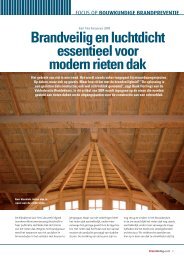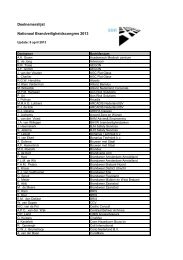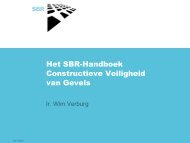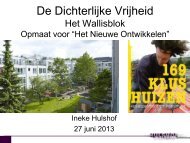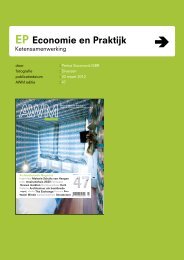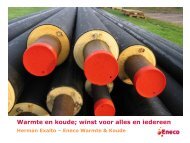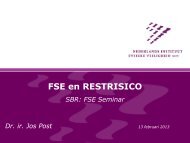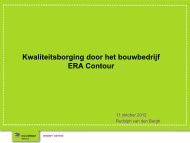Ruud van Herpen â Lector Fire Safety Engineering, Ensched e - SBR
Ruud van Herpen â Lector Fire Safety Engineering, Ensched e - SBR
Ruud van Herpen â Lector Fire Safety Engineering, Ensched e - SBR
- No tags were found...
You also want an ePaper? Increase the reach of your titles
YUMPU automatically turns print PDFs into web optimized ePapers that Google loves.
Tall buildings<strong>Safety</strong> by risk assessment<strong>Ruud</strong> <strong>van</strong> <strong>Herpen</strong> MSc. FI<strong>Fire</strong>EProfessor <strong>Fire</strong> safety of buildingsChairman VVBAKom verder. Saxion.
<strong>Safety</strong> definitionsKom verder. Saxion.Prescriptive rules:– Building Code (2003 / 2012)• many fixed requirements for fire safetyto control the maximum effect• easy yes/no judgment• obstruction to innovationPerformance-based approach:– <strong>Safety</strong> = (Risk) -1– Risk assessment:• Probability and consequences– Project-specific parameters• Source and response– Taylor-made fire safety (FSE)2
<strong>Safety</strong> definitionsKom verder. Saxion.Risk = Probability x (Consequences) nConsequences defined as failure of a risksubsystem:– Acceptable failure of egress route(s)– Acceptable failure of attack route(s)– Acceptable failure of compartment (acceptable spreadof fire and smoke)– Acceptable failure of building structure– Acceptable failure of environmental protectionTall buildings > 70 meter are beyond the scope ofthe building code different approach needed!3
<strong>Safety</strong> definitionsKom verder. Saxion.Source and response in a risk-based approachSOURCENatural fire concept (projectspecificsource: fuel andenclosure characteristics)RESPONSE (I)Response of installationcomponents (detection,alarm, suppression)[ACTIVE]Risk assessmentRESPONSE (B)Response of buildingcomponents(loadbearing elemens, buildingstructure,separationconstructions)[PASSIVE]RESPONSE (O)Response of people, theorganisation for evacuationand fire relief operation[ACTIVE]Film4
Kom verder. Saxion.Source: fireInteraction between fire and enclosure– Influence fire enclosure– Influence fire enclosure5
Natural fire conceptKom verder. Saxion.In stead of a standard fire curve…… a natural scenariofor the heat release rate Local fireCompartment fire6
Natural fire conceptKom verder. Saxion.Two critical events:– Start of a local fireDepends onbuildingsfunction andcompartment area– Flashover tocompartment fireDepends on RHR-scenarioand the characteristics ofthe compartment envelope7
Kom verder. Saxion.Natural fire conceptPre flashover: two zones(local fire)Post flashover: one mixed zone(compartment fire)flashoverflash-over conditions8
Natural fire conceptKom verder. Saxion.Pre flashover:– Safe egress in compartment– Safe attack in compartment (offensive fire attack)Post flashover:– Safe egress route(s)– Safe attack route(s)– Safe compartments (limitation spread of fire andsmoke)– Safe building structure– Safe environment9
Risk-based approachKom verder. Saxion.Semi-probabilistic approach:– ‘caracteristic thermal load’ conform Eurocode 1(NEN-EN 1991-1-2+NB): heat release rate with riskfactor– thermal and mechanical response of loadbearingstructures and separation constructions based onEurocode or equivalent fire duration (standard firecurve)– In combination with risk assessment in risksubsystems:• Structural failure• Compartment failure• Egress failure• <strong>Fire</strong>-fighting failure10
Risk-based approachKom verder. Saxion.How to assess risks if there are no objectives? Use the risk-level of the (prescriptive) building code!– Extrapolate the risk level from a normal multi-storey building thatfits in the building code to a highrise building– For all subsystemsreferencehighrise11
Case: office buildingKom verder. Saxion.Reference building:– 10 storeys– glass facadeHighrise building:– 50 storeys– glass facadeAll floors havesame lay-out12
Case: office buildingKom verder. Saxion.13
Case: office buildingKom verder. Saxion.Common fire safety measures:– Lobby (core area) outside fire compartment– 2 escape routes (staircases)– Safe acces routes for fire brigade– Elevator for fire brigadeAdditional fire safety measures for highrise:– Pressurized escape routes(core/lobby)– Sprinklered compartments– Longer egress time (30 min.) safer escape routes!14
Case: office buildingKom verder. Saxion.Consequences in equivalent fire duration (standardfire curve) for different risk subsystems:15
Case: office buildingKom verder. Saxion.16
Case: office buildingKom verder. Saxion.17
Case: office buildingKom verder. Saxion.18
Case: office buildingKom verder. Saxion.19
Thanks for your attentionKom verder. Saxion.Risk-based approach only for special projects?r.a.p.<strong>van</strong>herpen@saxion.nl20



